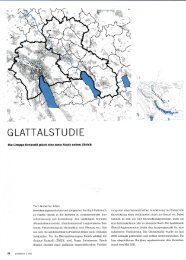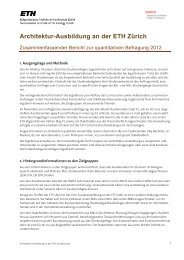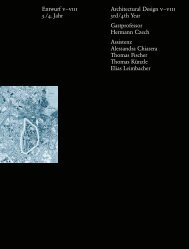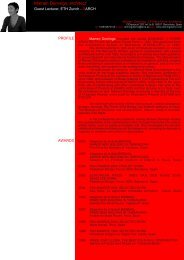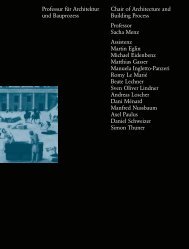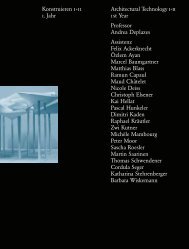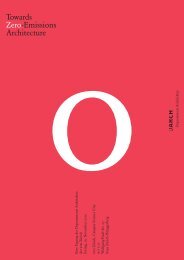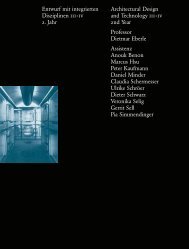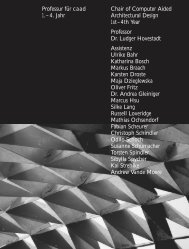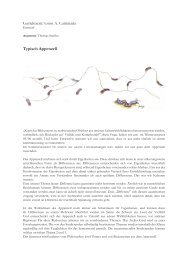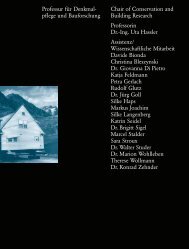Jahrbuch PDF (63MB) - ETH Zurich - ETH Zürich
Jahrbuch PDF (63MB) - ETH Zurich - ETH Zürich
Jahrbuch PDF (63MB) - ETH Zurich - ETH Zürich
Erfolgreiche ePaper selbst erstellen
Machen Sie aus Ihren PDF Publikationen ein blätterbares Flipbook mit unserer einzigartigen Google optimierten e-Paper Software.
Dozent<br />
Dr. Ulrich Pfammatter<br />
Geschichte der Bautechnik<br />
in Fallstudien<br />
Die Baukultur weist seit dem Pantheon in Rom und seiner<br />
an die Grenze gehenden Tragstruktur eine Tendenz<br />
zur Auflösung der Masse auf. Der Raum tendiert zum<br />
«befreiten Raum», die Mauer erlebt Metamorphosen<br />
zur Wand und zur Haut, neue Materialien und Technologien<br />
werden zunehmend aus der Automobil-, Schiffsoder<br />
Flugzeugbautechnik und Weltraumtechnologie<br />
in Bautechniken «übersetzt».<br />
Die Entwicklung ist ungebrochen. Der zuerst in der<br />
Textilindustrie der englischen «midlands» zwischen 1792<br />
und 1802 entstandene «Skelettbau» und das Patent von<br />
Samuel Wyatt für eine vollständige Eisenskeletttypologie<br />
im Jahr 1800 befreiten Schritt für Schritt die traditionelle<br />
gemauerte, massive Fassade von Tragfunktionen – der<br />
Entwicklung der vorgehängten Gebäudehülle, der «curtain<br />
wall» war der Weg bereitet. Ein permanenter Entwicklungsmotor<br />
ist die industrielle Produktion. Die Ablösung<br />
handwerklicher Fertigungs- durch industrielle Produktionsmethoden<br />
führte von der Bedarfs- zur Markt- oder<br />
Massenproduktion, und die mit caad verknüpfte computergesteuerte<br />
Komponenten- oder Systemherstellung<br />
erleichterte den Übergang von der Massen- zur Massproduktion.<br />
Der bautechnische Hintergrund der architektonischen<br />
Gestaltung hat sich seit der Industriellen Revolution<br />
in verschiedenen thematischen Entwicklungslinien manifestiert<br />
und im Kontext gesellschaftspolitischer, ökonomischer<br />
und soziokultureller Bedingungen verändert,<br />
sowohl in den materialtechnischen Bereichen Glas und<br />
Kunststoffe, Eisen und Metalle, Beton und Verbundbaustoffe<br />
(composites) als auch in den Problemfeldern der<br />
Prozesse wie Industrialisierung und Bausysteme, «curtain<br />
walls» und «sustainable building design».<br />
Jedes dieser Entwurfsfelder hat Geschichte, Aktualität<br />
und Perspektiven an der Schwelle der Zukunft. Hinter<br />
den prägenden Erfindungen, innovativen Experimenten<br />
und neuen Entwicklungen der letzten zweihundert<br />
Jahre standen Denkmodelle und Denkschulen, die<br />
Zukünftiges vorwegnahmen, den Nährboden für Neues<br />
vorbereiteten und Meilensteine für weitergehende Entwicklungen<br />
markierten. Daher lautet der programmatische<br />
Titel der Vorlesung «In die Zukunft gebaut».<br />
243<br />
History of Building Technology<br />
in Case Studies<br />
Even since the builders of the Pantheon in Rome dared<br />
to push load-bearing capacities to their very limits,<br />
architecture has aimed at defying solid mass. Spaces have<br />
increasingly opened up, walls have become thinner<br />
until they metamorphosed into a mere skin and new<br />
materials and techniques, imported from the automobile,<br />
shipbuilding, aviation and aerospace industries,<br />
have been translated into construction methods.<br />
Development still continues apace. The skeleton construction<br />
system first devised in the textile industry of<br />
the British Midlands between 1792 and 1802 and Samuel<br />
Wyatt’s Patent of a complete iron skeleton typology<br />
from 1800 gradually freed the traditional masonry-built<br />
wall from its load-bearing function, paving the way for<br />
the development of the suspended curtain-wall façade. Industrial<br />
production has always been a driving force behind<br />
architectural innovation. As artisanal craftsmanship<br />
was replaced by industrial manufacturing methods, individually<br />
commissioned works were replaced by marketdriven<br />
production and mass production. With the advent<br />
of computer-controlled manufacturing of components<br />
and systems, cad software facilitated the transition from<br />
mass production to tailor-made production.<br />
The technical, constructive background of architectural<br />
design has followed various developmental trajectories<br />
since the industrial revolution and has been influenced<br />
by changing political, economic and socio-cultural<br />
circumstances, for instance, with respect to materials such<br />
as glass and plastics, iron and metal, concrete and composites,<br />
as well as problem areas within such processes as<br />
industrialization and building systems, curtain walls<br />
and sustainable building design.<br />
Each of these fields of design has a history, a contemporary<br />
presence and perspectives at the threshold of<br />
the future. Behind the salient inventions, innovative<br />
experiments and new developments of the last 200 years<br />
lie theoretical models and schools of thought that<br />
anticipated the future, laid the groundwork for innovation<br />
and marked the milestones for continuing development<br />
– hence the programmatic title of the lecture<br />
course: ‘building the future’.<br />
Lehrbeauftragter Departement Architektur<br />
Ulrich Pfammatter



